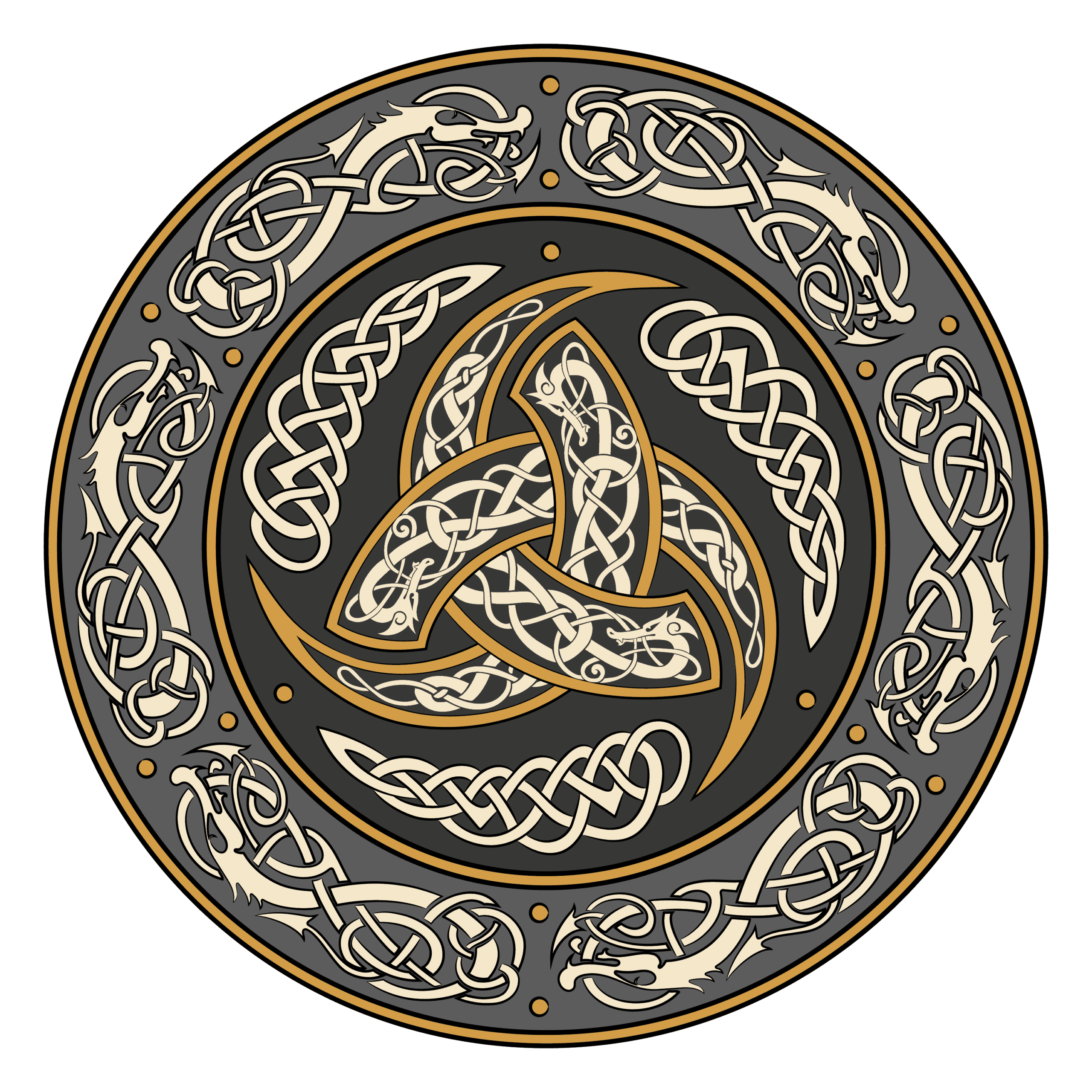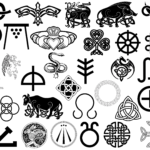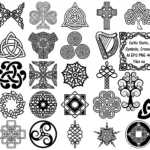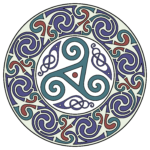Get ready to take a mind-blowing trip through the amazing world of Celtic symbols. These ancient signs are like time capsules, holding secrets and stories from a time long gone. We’ll dive into their meanings and uncover the fascinating ways they’ve been used throughout history. From intricate knots to powerful animals, these symbols have played a big role in shaping our understanding of the world around us. So, sit back, relax, and let’s unlock the enchanting world of Celtic symbolism!
Celtic Symbols: Unlocking the Enchanting World of Ancient Meanings
Step into the enchanting world of Celtic symbols, where intricate designs and hidden meanings abound. These symbols, passed down through generations, hold deep cultural and spiritual significance, offering a glimpse into the rich tapestry of ancient Celtic traditions.
The Celtic Tree of Life: A Sacred Bond
Imagine the majestic oak tree, its roots firmly planted in the earth and branches reaching towards the heavens. The Celtic Tree of Life mirrors this sacred bond, representing the interconnectedness of heaven, earth, and the underworld. Its interwoven design symbolizes the strength and resilience of the Celtic people, the foundation upon which their culture thrived.
The Celtic Cross: A Fusion of Faith and Tradition
Brought to Ireland centuries ago, the Celtic Cross seamlessly blends Christian and Celtic elements. Its upright bar signifies heaven’s embrace, while the crossbar represents the earthly realm. The circle, an eternal symbol, encompasses the harmonious union of the divine and the human, a testament to the intertwining of faith and tradition.
The Dara Knot: Strength in Harmony
Inspired by the ancient Irish oak tree, the Dara Knot radiates strength and perseverance. Its intricate interweaving creates a mesmerizing balance, reminding us to find our center amidst life’s inevitable challenges. Like the oak withstanding fierce winds, the Dara Knot empowers us to face adversity with unwavering determination.
Ailm: The Mythical Symbol of Courage
In the realm of Celtic mythology, Ailm, a mystical creature, embodies both strength and agility. Its portrayal in Celtic art serves as a powerful reminder to embrace our own unique gifts. Ailm inspires us to face life’s adventures with the same courage and determination it possesses, reminding us that within us lies the potential for greatness.
The Triquetra: The Trinity of Life
Known as the Trinity Knot, the Triquetra symbolizes the eternal trinity of mind, body, and spirit. Its three intertwined loops dance together, representing the interconnectedness of life’s cycles. The Triquetra reminds us that balance and harmony exist within us all, fostering a deep sense of unity and belonging.
Discover the profound meanings behind ancient symbols, unlocking the secrets they hold. Explore the enigmatic world of gaelic symbols and delve into the rich tapestry of irish celtic symbols. Uncover the hidden messages within scottish symbols, and find solace in the meaningful ancient symbols that have adorned our world for centuries.
Who were the Celts and what is their connection to these symbols?
Picture this: you’re walking through the countryside, surrounded by rolling green hills and whispering trees. You stumble upon an ancient monument covered in intricate carvings. These carvings are Celtic symbols, remnants of a time when the Celts roamed these lands, their beliefs and customs forever entwined with the beauty of nature.
The Celts were not a single nation but rather a group of tribes from Central Europe who shared similar languages, beliefs, and traditions. They migrated to Britain and Ireland thousands of years ago, leaving behind a rich legacy of art, mythology, and symbolism.
Celtic symbols are deeply rooted in the Celts’ connection to nature. They saw the world as a living, interconnected web, where everything from the mighty oak tree to the smallest insect had a place and purpose. This reverence for nature is evident in the intricate patterns and motifs that adorn Celtic artwork, from jewelry and clothing to the carvings on stone monuments.
These symbols were not just decorative flourishes; they were imbued with meaning, representing important concepts such as strength, life, motherhood, and the cyclical nature of existence. The Celts believed that the interconnectedness of all things was reflected in these symbols, which served as a reminder of the harmony and balance found in the natural world.
Today, Celtic symbols continue to be used in a variety of ways. Some people incorporate them into their décor to evoke the ancient spirit of the Celts, while others wear them as jewelry to display their Celtic heritage. Whether for decorative purposes or as a symbol of cultural pride, Celtic symbols remain a timeless reminder of the rich history and spiritual traditions of the Celtic people.
What are the different types of Celtic symbols and what do they represent?
Imagine a world where simple shapes and patterns hold profound meanings, where each stroke carries a story of its own. That’s the world of Celtic symbols, a treasure trove of ancient wisdom passed down through generations. From the sun-kissed circle to the ever-evolving spiral, these symbols are more than just pretty designs; they’re portals to a fascinating world steeped in beliefs and traditions.
Picture a round circle, like the golden sun in the sky. It’s no ordinary circle; it’s a symbol of unity and wholeness, reminding us that we are all part of a bigger picture. Or take the spiral, like a lazy river flowing through time. It’s not just a shape; it’s a representation of growth and cosmic energy, reminding us that life is an ever-evolving dance.
But wait, there’s more! Celtic symbols love to play with duality. Meet the twin spirals, two spirals dancing around each other, embracing balance and reminding us that opposites can coexist. And the triple spirals? They’re like a time capsule, capturing the past, present, and future in one beautiful twist.
Celtic symbols don’t stop there. There’s the Triquetra, the Trinity Knot, a symbol so powerful it represents the interconnectedness of mind, body, and spirit. And let’s not forget the Celtic Cross, a blend of Christian and Celtic traditions, signifying the meeting of heaven and earth.
But wait, there’s more! The Celtic Five Fold symbolizes protection and spirituality, encapsulating the cosmic wisdom of the universe. And the Dara Knot, inspired by the mighty oak tree, embodies strength and resilience, reminding us that we can weather any storm.
Finally, there’s the Ailm, a majestic creature,象征勇气和敏捷,激励我们追求高尚的事业。
So there you have it, a glimpse into the fascinating world of Celtic symbols. Each one a treasure, a story to be told, and a reminder of our connection to the past and the interconnectedness of all things.
How have Celtic symbols been used throughout history?
Celtic symbols have been around for centuries, and they’ve been used in all sorts of different ways. Here’s a rundown of some of the most notable examples:
- Religious and spiritual beliefs: The Celts were a deeply spiritual people, and their symbols often reflected their beliefs about the world around them. For example, the triskelion, which is a three-legged spiral, represented the three realms of earth, sea, and sky. The Celtic Cross, which is a cross with a circle around it, represented the sun and the four seasons.
- Cultural identity: Celtic symbols were also used to represent different tribes and clans. Each tribe had its own unique set of symbols, which were used to identify them on clothing, shields, and other objects.
- Protection and good fortune: Many Celtic symbols were believed to have protective powers or to bring good luck. For example, the shamrock was thought to protect against evil spirits, and the four-leaf clover was thought to bring good luck.
- Decorative arts: Celtic symbols were also used extensively in decorative arts. They were often found on jewelry, metalwork, and stone carvings. The intricate designs of these symbols showcased the skill and artistry of Celtic craftsmen.
In modern times, Celtic symbols continue to be popular in Ireland and other Celtic countries. They are used in jewelry, artwork, and other cultural expressions. Celtic symbols have also been adopted by various organizations and individuals worldwide, representing pride in Celtic roots and an appreciation for their timeless beauty and wisdom.
FAQ
Q1: What is the origin and significance of Celtic symbols?
A1: Celtic symbols originated thousands of years ago among the Celtic tribes of Central Europe. These symbols are deeply rooted in Celtic beliefs and traditions and represent the interconnectedness and cyclical nature of life. They often draw inspiration from nature, spirituality, and the animal kingdom.
Q2: How have Celtic symbols evolved over time?
A2: Celtic symbols have evolved over time due to the influence of Christianity and cultural interactions within Ireland and other Celtic regions. However, many traditional symbols have maintained their core meanings and significance, continuing to represent ancient Celtic beliefs and values.
Q3: What are some of the most common Celtic symbols and their meanings?
A3: Some of the most common Celtic symbols include the Triskelion, representing balance and movement; the Triquetra, symbolizing the unity of mind, body, and spirit; the Celtic Cross, a blend of Christian and Celtic influences representing faith and spirituality; and the Celtic Tree of Life, embodying the connection between the physical and spiritual realms.
Q4: How can Celtic symbols be interpreted in modern contexts?
A4: Celtic symbols can be interpreted in modern contexts through their timeless meanings and symbolism. They can represent pride in Celtic heritage, connection to nature, or personal beliefs and values. Their versatility and rich history make them relevant in various areas, including art, jewelry, literature, and spiritual practices.
Q5: Are Celtic symbols only associated with Ireland?
A5: While Celtic symbols are often associated with Ireland, they are not exclusive to Irish culture. They encompass a broader Celtic heritage that includes Scotland, Wales, and other regions with Celtic roots. The symbols represent the shared beliefs and traditions of the Celtic peoples across these regions.
- China II Review: Delicious Food & Speedy Service - April 17, 2025
- Understand Virginia’s Flag: History & Debate - April 17, 2025
- Explore Long Island’s Map: Unique Regions & Insights - April 17, 2025

















Comments are closed.